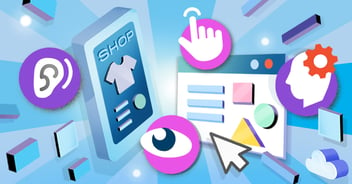The intrinsic value of a mobile radio app is that your voice can be with listeners everywhere they go. Many businesses making the transition to digital apps are amazed at the features they can add. For a custom radio app, these might include:
- Push notifications for a favorite show
- Offline downloads
- Live streaming
- Carplay and Android Auto
- User comments and ratings
- Pictures and media files to accompany and enhance audio content
- Integrations with other music players for better music discovery, as we created for KCRW
- Custom feeds
- Curated playlists
- Audio shoutouts and dedications
- App analytics
- Social media integrations
- Sharing options
- Membership perks
- …And so much more.
Are you ready to boost listenership, increase brand loyalty, and deepen connections with your audience? Let’s take a look at how a custom radio app can make it happen.
Technology and the Future of Broadcast Radio
Traditional AM/FM radio has the largest reach of any media format in the world. As of 2020, 83 percent of U.S. adults listened to the radio every week. But let’s look at that number in a wider context. It’s a drop from the 89 percent who listened every week in 2019, and the 93 percent who listened every week in 2017. Although traditional radio reaches more people than any other format, consumers are listening to more hours per year of digital audio (55 percent) than AM/FM radio (45 percent). With the drop in revenue generated in 2020, traditional radio stations are heeding the wake-up call and finally giving modern audiences a custom radio app.
People aren’t listening to less audio content.
On the contrary, with easy access to content on demand while they drive, jog, or do the dishes, audio has become the premier media resource, especially among Millennials. Listeners are simply shifting to different formats for audio consumption. They connect their phones to car speakers, smart home speakers, and Bluetooth headphones, rather than tuning a radio dial.
Where Are Your Listeners Listening?
With plenty of ways for people to access audio content, multimedia giants now dominate the digital landscape with robust technology and complicated subscription models. This means that your station—which used to only compete with owned physical media and anyone else on your local airwaves—is suddenly competing on a much larger scale.
The good news is, you can increase your potential audience and fan base—if you do it right.
Let’s take a quick look at the players in the digital audio space and the features that listeners love about each:
- Satellite radio (digital broadcast, ie., SiriusXM)
- Similar to traditional radio, they use digital and satellite technology to cast a clear signal from anywhere to anywhere—worldwide.
- Streaming radio apps (Simple Radio, RadioFM, iHeartRadio, etc.)
- These translate broadcast radio signals into digital form for access using a computer, tablet, smart speaker, or smartphone. These apps usually offer many partner radio stations within their network.
- Streaming music library apps (Spotify, Apple Music, etc.)
- Best-known thanks to their direct track availability, but farthest removed from the traditional “radio show” format, these apps offer custom, automatic stations or talk radio in podcast format.
You Need to Own Your Platform
Considering the fact that you can stream your station to these existing platforms, or repackage your radio shows for podcast streaming, what’s the purpose of investing in a custom radio app? Let’s explore some of the most pressing concerns of radio clients we’ve worked with:
Control Your Own Ad Revenue
The most immediate benefit of a custom radio app is that 100 percent of the ad revenue will go to you, rather than the platform you use to reach your listeners. Spotify, for example, takes a 30 percent cut of profits. Not only should you be able to profit from the revenue generated by your content, but you should have control over how you fund production and which advertisers you partner with.
Brand Loyalty
Many of the platforms listed above can be excellent venues for new media discovery. However, once you have a loyal audience, it’s best to communicate in a space with fewer distractions.
Radio stations are more connected to their audiences than any other form of media.
As such, you have enormous potential for continually re-engaging with your listenership by leading them to new shows, events, memberships, and other ways to connect with your brand.
Cross-Promotion
Partnerships and membership models are a great way to connect with your community and add value for your listeners. In our custom app for KCRW, we created a member section called Fringe Benefits that shows local businesses within a listener’s radius that will accept their KCRW member discount. Rather than displaying a physical card, shoppers are able to show their membership by simply opening the app. From April 2021 to April 2022, KCRW saw a 43.8 percent increase in these virtual membership cards.
Listener Data and User Experience
An app creates a new space for users to interact with your station in tactile ways. You own design, categorization, and listening options. And that allows you to give your listeners a personalized, branded experience. Our radio app for Ancient Faith Radio allows users to save a favorites list, follow programs and artists, and get recommendations based on their listening history. You can use data to learn more about your users’ interests, optimize ad experiences, and make every interaction with your content feel personal.
Complete Control Over Your Content
When your content is folded into a large platform, your voice can be lost. Choices over what should be censored, which ads to promote, and what kind of commentary you’re allowed to offer won’t always rest solely in your hands if you’re beholden to a larger streaming service. Your listeners tune in to hear your voice and that shouldn’t change. A custom radio app gives you the power to continue sharing the unique voice your listeners know and trust. This was a vital factor for our client Ancient Faith Radio, whose listenership trusts them as an independent, listener-supported voice.
Challenges Radio Stations Face When They Go Digital
Our team has helped numerous private and public radio stations with their digital makeover. We’ve learned a few things about what can go wrong, and what can go extremely right. Here are some big mistakes to avoid:
1: Failing to Play to Your Key Strength: Knowing Your Audience
60 percent of radio journalists and broadcasters feel extremely connected to their audience, versus 45 percent or less of print, television, or online journalists. Your listeners feel connected to you too!
This community-building isn’t something that mega-media streaming services can duplicate. Creating a custom app with the preferences of your audience in mind helps your radio app become more than the same service from a different input source.
2: Amassing Technical Debt With Cheap, Disparate Technology Options
There are plenty of turnkey or white-label solutions for radio apps. While this may be a good temporary measure, it’s easy for your users to spot budget solutions, and could cause you to accrue technical debt.
Technical debt is a common challenge as companies gradually scale up their digital assets while keeping a tight budget. It may seem practical at first, but it can gradually create broken frameworks that render your app useless unless you pour more and more of your budget into patches and temporary fixes.
In the case of our client WBUR, they had been limping along for years with an outdated app design and very limited technical capabilities. Their code base was becoming obsolete, making it harder and harder to make even simple updates. Utilizing React Native, our team developed a brand new, long-lasting, and flexible framework that set them up to thrive in a digital ecosystem for years to come.
3: Taking Shortcuts That Downgrade the User Experience
Some technical details unique to audio streaming apps are much more complicated behind the scenes than you’d think.
For example, pausing on a live broadcast is much more difficult than it sounds. However, your audience expects this functionality. An experienced app developer will ensure the quality of your user’s experience and retain engagement on your app. After all, it’s easy for your listeners to move to another platform that gives them the options they want if you can’t deliver.
Vincit Is the Go-To Digital Tech Partner for Radio Stations
Vincit has partnered with numerous public and private radio organizations to jumpstart their digital transformation. We know the finicky details that come with creating an audio app, and we’re bursting with ideas to help your transition.
Drawing on your insights about your audience, and our experience with beautiful UI design, we help you dream up a one-of-a-kind experience, rich with features that your listeners will love. Then, our devs execute the design to create a seamless tech solution that will increase your listener retention and loyalty.
Contact us to set up a consultation and learn more about what we can do for you.



